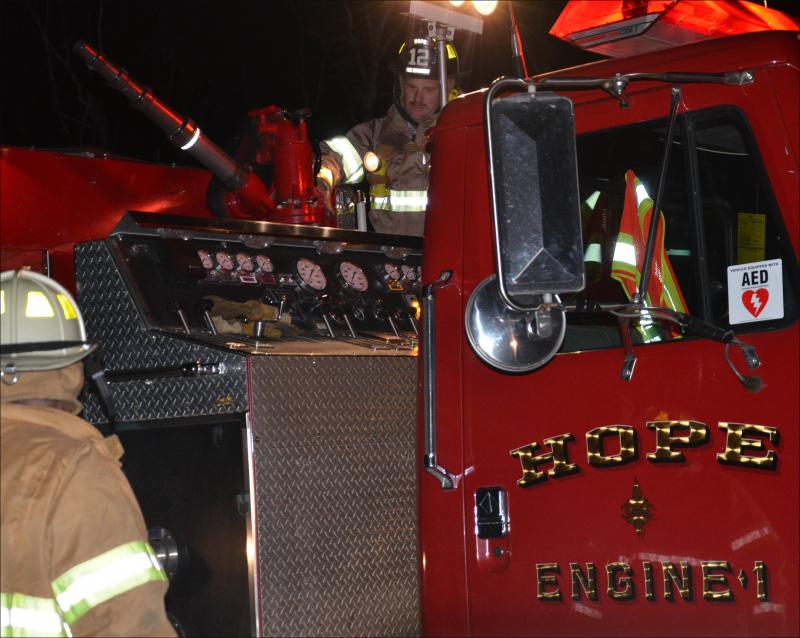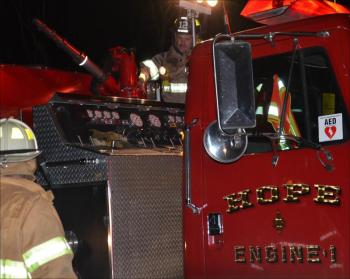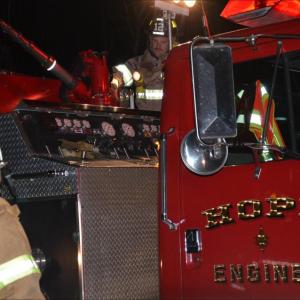Hope firefighters concluded one eventful week
HOPE — Emergency responders do not like to talk in terms of a day or night — or any period of time — as being "quiet." The preferred word is "uneventful." But, last week's accident involving yet another vehicle upending in Hope pushed the number of emergency calls made to the town's Fire Department up to 32 for Year 2012. And eight of those calls came in sometime during the eventful week following Nov. 14.
For a town of 1,423, that is a lot.
Hope Fire Chief Clarence Keller noted that until mid-November, the number of fire department calls rounded out for the year at 24.
Add eight more calls in a span of seven days — "That's a quarter again in one week," said Keller.
The most recent accident occured Wednesday night, Nov. 21, around 9:30 p.m. on Route 105, when Carl Stoddard, 69, of Hope was traveling east up a hill toward Hope Corner in his Toyota pickup. Temperatures that night were hovering around the freezing mark and Stoddard apparently encountered a frosty spot on the road, causing him to lose control of her truck. He spun out, went sideways, hit the shoulder of the road, anf flipped over onto the truck's roof.
As Hope firefighters arrived they were met with a road that was quickly glazing over in many areas, creating hazardous conditions.
"When we first got there, the road was like a glaze," said Keller. "You couldn't stand up in the road."
Meanwhile, Stoddard was pulling himself out of the truck, and when Camden First Aid Association arrived, it was determined he had a minor bruise and laceration on top of his head. He was not transported to the hospital.
Firefighters contended with the slippery pavement, and called for sanding, eventually clearing the scene at 11 p.m.
Other calls that came in for the 24-member Hope volunteer fire department over the week included a tragic accident on Route 17 the previous night, Nov. 21, that took the life of Brian Edgecomb, of Rockland, after his car went off the road, rolled and struck a tree.
On Nov. 15, Hope firefighters were called to a sharp bend in the road on Route 235 where the pickup that Daniel Dodge was driving landed on its side after he failed to negotiate the curve. Hope firefighters cut through the windshield and helped him climb out of his crushed pickup. After he was treated and released for minor injuries, Knox County Sheriff deputies arrested him for operating under the influence and operating a motor vehicle while his license was suspended.
Other calls coming in during the week-spread included a residential propane alarm, and a 2:30 a.m. fire alarm at Hope Elephants, which was attributed to condensation build-up in the alarm mechanism. Rosie and Opal were fine.
About black ice
According to Maine's risk management division, black ice frequently forms in the late winter and early spring. Black ice is almost invisible to the naked eye and is frequently mistaken for a wet or newly paved road. It can form even when it's not raining or snowing. Melting snow that runs across the road or condensation from overnight dew can freeze forming a thin layer of ice that creates slick road conditions.
Watch for:
Pavement that looks dark, wet or like new asphalt.
Low-lying areas that may have standing water or run off from nearby melting snow banks or puddles.
Bridges and underpasses and any road areas that are shaded from the sun.
Any time the temperature is below 40 degrees F.
The American Automobile Association recommends that motorists practice slow-speed maneuvers on an empty snow or ice covered parking lot. The AAA has a lot of winter driving tips! You should also look through your owner's manual and familiarize yourself with your vehicle's braking system and other features.
Wear safety belts every time you get into a vehicle. Be sure all children and passengers are secured in proper restraints, too.
Slow down. Posted speed limits are for ideal travel conditions. Driving at reduced speeds is the best precautionary measure against any misfortune while driving on slippery roads.
Allow more time to travel. Resist the temptation to drive faster. Allow extra time not only for the reduced speeds, but for potential problems on the road.
When the roads are wet or look wet, watch the vehicle in front of you. If it is not leaving tracks or its wheels are not "throwing" water, it is probably black ice and not just wet
Look well ahead to compensate for the greater distances required when driving on slippery surfaces, focus your attention as far ahead as possible-at least 20 to 30 seconds.
Drive with your head lights on. This will turn on your tail lights and allow others to see you almost twice as far away. Being visible will give others time to avoid hitting you.
Be especially leery when driving your car into shaded areas and slow your vehicle down when you encounter such areas.
Avoid driving while fatigued.
Maintain more space. Increase your margin of safety. Don't tailgate. Maintain a minimum of 8 to 10 seconds in following distance.
Anticipate problems. On slick surfaces, any abrupt maneuver will increase the probability of losing vehicle control. Skids can best be avoided by anticipating lane changes, turns and curves, slowing down in advance, and by making smooth, precise movements of the steering wheel.
Use chains in deep snow and on icy surfaces. Check state and local laws before installing chains, and drive at slower speeds to avoid damage to the tires and vehicle.
Do not use cruise control. Winter driving requires you to be in full control.Steer with smooth and precise movements. Changing lanes too quickly and jerky steering while braking or accelerating can cause skidding.
Braking tips on black ice
1) Braking without anti-lock brakes: Use the heel-and-toe method. Keep your heel on the floor and use your toes to press the brake pedal firmly just short of locking up the wheels. If the wheels lock, release the pressure on the pedal, and press again in the same way. Repeat this until you come to a full stop.
2) Braking with anti-lock brakes: Apply the brakes. Do not remove your foot from the brake pedal or pump the brakes. The ABS should keep the brakes from locking while allowing you to steer as you continue to slow the vehicle down.
In both cases, if your vehicle begins to skid, remember to steer in the direction of the skid. You may also find it advantageous to put your transmission in neutral while trying to stop on black ice.
Editorial Director Lynda Clancy can be reached at lyndaclancy@PenBayPilot.com; 706-6657.
Event Date
Address
United States

























